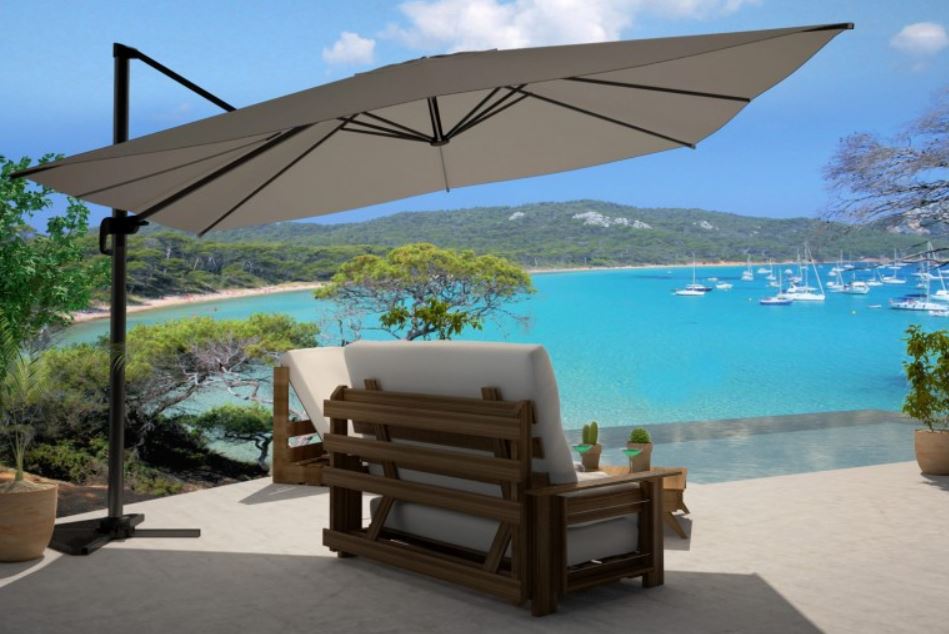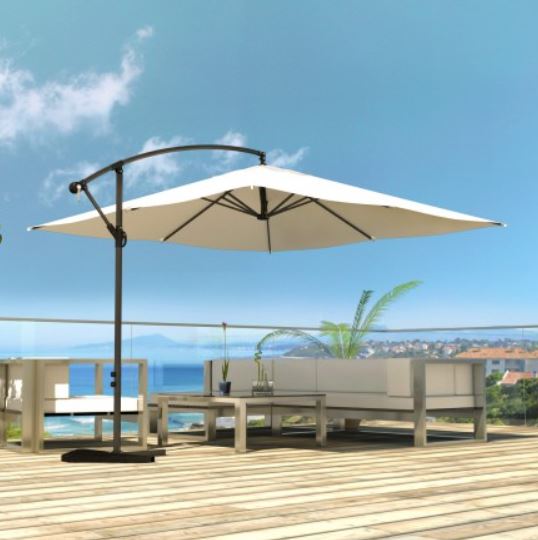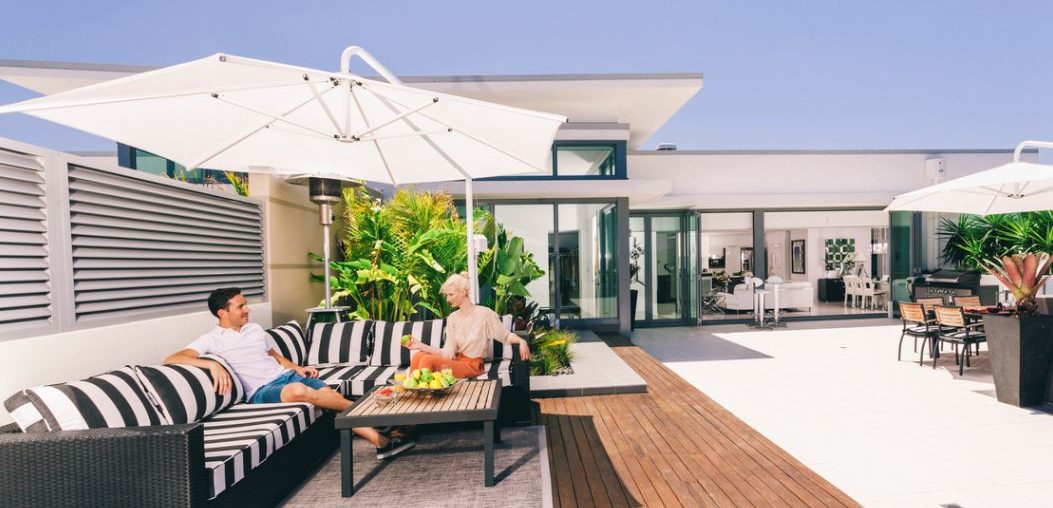With the return of the sun and sunny days, we want to make the most of our outdoor space. When it’s really hot, the parasol is our best friend. Indispensable, it allows you to easily protect yourself from direct sunlight. To find the ideal model, you have to ask yourself the right questions. Here are some elements to help you make your choice.
What size for your parasol?
The first determining criterion to make the right choice is to identify the surface that it will have to protect. Is it simply to provide protection for two or three sun loungers or rather for a larger or smaller dining area? Where are you going to put it: on a balcony, a terrace, a small space in the garden or by the pool? These are important questions that can determine the size of your parasol. Indeed, the goal is to be able to cover the entire surface concerned. This is called a shading or span surface. You should know that a parasol, 4 x 3 meters, offers a shading area of 12 m².
If you do not have a lot of space, then choose an XXS model which can take a semi-round or semi-rectangular shape in order to offer protection to small spaces. It is very practical on balconies or apartment terraces with a small width for example.
How to choose the shape of your parasol?
Today you have a very important choice to select your parasol. Between straight parasol and offset parasol, round, rectangular and square parasol, you can choose according to your needs. It is necessary to choose the model adapted to the configuration and to the space in which you wish to place it.
The right parasol will be suitable for a terrace or areas exposed to the wind. If you have a table that can accommodate the parasol base, it is ideal for small spaces. Additional advantage: you will not be bothered by the various objects and furniture on your terrace to open or close the parasol. Handling is faster and simpler.
A deported parasol requires more space during handling. The advantage of this parasol is mainly due to the fact that its rotating base is very practical since you orient it as you wish, but moreover you can open it on the garden side and then position it towards the terrace without problem. You adapt it according to the orientation of the sun without having to move the foot of the latter.
However, before making your decision, pay attention to the dimensions which must perfectly match those of your terrace. In the same way if it is an apartment terrace, correctly assess the height you have.
The round parasol is the most suitable model for small spaces and round tables.
The square or rectangular parasol is easy to put on a terrace, along the wall, in a corner, above the garden table.

How to choose the pole of your parasol?
The mas of a parasol is offered in an anti-corrosion and resistant material: aluminum in 80% of cases.
The anti-rust treated steel pole is most often used in entry-level parasols.
A parasol with an aluminum pole is strongly recommended for its strength and resistance, especially if it is a deported parasol or if it is large enough.
You should know that there are also wooden poles, in an ethnic or tropical inspiration. They are more fragile and require a little maintenance to remain perfectly beautiful.
How to choose the base of your parasol?
The base is chosen according to the model for which you have opted. If you have decided to take a rather large model, the base will have to be very heavy. Deported parasols with a concrete base are strongly recommended. To guide you, know that for a parasol 3 meters in diameter, the base should weigh about 80 kg to be sure that it holds it perfectly. The base must also be high enough to ensure better support. Always avoid plastic bases which are too light. The base with wheels is also very practical, it allows you to move your parasol much more easily. Only downside: this is only possible on large terraces.
How to choose the canvas for your parasol?
The canvas is also an essential component of your choice. It is necessary in particular to take into account its grammage or its thickness.
The thinnest fabrics are the least expensive, they generally have a weight of around 140 g / m².
To be more qualitative, they must be between 250 and 300 g / m² and the thickest go up to 400 g / m².
Material side: there are also different choices.
Polyester canvas is the most affordable, but it also wears out faster. Protection is less if the fabric is not treated against UV rays.
Acrylic canvas : it is more resistant and keeps its colors longer, even if it is exposed for a long time and often to the sun. There are anti-water-repellent treated models that allow rain to slide off the canvas.
Cotton canvas : it is very resistant, especially when the cotton is coated, but it is also the most expensive.
There are also models with removable canvas which can be cleaned more easily.
How to choose the color?
The color of a parasol is not just a matter of taste, you should know that it has an influence on the life of the parasol and on the level of protection offered.
We must in particular take into account the significant amount of sunshine that we know today. Dark colors lose their luster faster than light shades. It should be protected with a cover when not in use.
Beige canvas umbrellas are dirtier, but they are less damaged.
Other option : favor canvases which are removable and can be changed. After a few years, you replace it and get a like-new parasol.
Light colors let light through while dark colors tend to darken.

Between straight parasol or deported parasol: which one to choose?
The deported parasol was very popular, because it really allows you to adapt the shade according to the evolution of the sun’s rays and that very easily.
The right parasol offers many models, which is a definite advantage. You have an important choice whether in relation to size, price and colors. It can be round, rectangular, square… It is the most suitable parasol if your garden table has a central hole. It has a drawback, it is not very flexible even if some of them are orientable, their possibilities remain limited.
The deported parasol is generally large in size, it can range from 2.5 meters in diameter to approximately 3 x 4. It is perfect for large terraces, the shading area being important. It tilts and rotates 360 ° to follow the sun and protect the area all day without moving the base.
If your outdoor space is really tight, the solution may be the wall parasol. In the open position, its telescopic arm is placed horizontally in relation to the wall. Once closed, it regains its upright and space-saving position. Thanks to its 180 ° mobility, it is efficient all day long. They can be square or hexagonal. They are available in two or three meters in diameter or even in 2 x 3 m or 3 x 4 m.
It is also necessary to pay attention to its options of use: its adjustable height or not, its degree of tilt or rotation, tilt at 180 or 360 °, push-pull opening system, pulley or crank. The crank is necessary on large parasols and on deported parasols.
Finally, there are winter umbrellas that are intended to offer you more comfort by protecting you from the cold so as to prolong the pleasure of the outdoors even when the cold begins to be felt. It is a real asset for the terrace or the garden. Heated, they offer you the possibility of enjoying your terrace or the garden during the autumn or spring seasons. However, you must be aware of the regulations surrounding these devices.
Read also :








